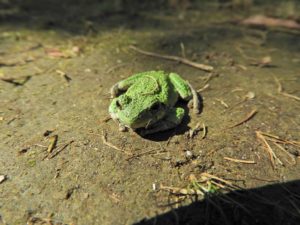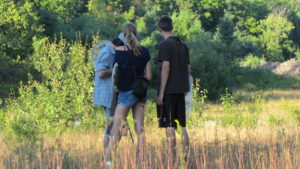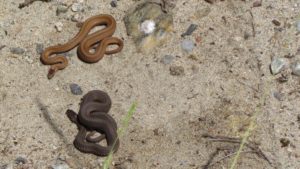Richard Headstrom — STEAMING Ahead with STEM 75 Years Ago

To view the photo-rich magazine version, click here.
Originally appears in the Spring 2021 issue.
You can download here a PDF version of this free article.
By Todd Beasley
Nearly 20 years after its formal introduction as an education model, STEM and its evolution into STEAM (and now STREAM) continues to be listed as an annual ‘trend’ to focus on. Like many teaching methods, STEM & STEAM were not novel, but simply acronym changes and enhancements of a previously successful model meant to keep pace with advances in educational research and rapidly advancing technology.
Regardless of which name is used, a major teaching practice question in today’s world is how do teachers bring STEM/STEAM alive to students both at home where so many are faced with a digital gap and at school where resources are limited? Even before the challenges of a pandemic, many schools lacked the resources to bring the outdoors alive within the classroom because using technology on a constrained budget is a challenge. Or is it? The answer sometimes requires us to simply take a glimpse into the past and modify our dispositions. This is where Richard Headstrom’s collective work comes into play. Headstrom was a progressive thought leader within science education at least a decade before the roots of STEM began. Let’s look back at his work and publications as well as some low-cost activities that can be completed with learners of all ages.
A history of familiar acronyms
Prior to being labeled as STEM/STEAM, this educational model sprouted from the post-WWII need for the US to challenge research leadership within science and technology due to Sputnik and the space race with Russia. Eventually, what evolved in the 1990s, after four decades of competition, was SMET, later changed to METS, and then finally STEM. Regardless of its label, the focus has always been the same: an interdisciplinary and applied approach to real-world applications within the career fields of computing, engineering, mathematics, and the sciences (physical and life) that incorporates technology, whether digital (think computers and apps) or electronic (think field tools like surveying equipment).
Over 75 years ago in 1941, Richard Headstrom was progressively paving the way for the development of this concept. He can be considered, like the great 20th-century horticulturist Liberty Hyde Bailey, a man ahead of his time, as his writings are still relevant with regards to using technology to teach. Back in the 1940s, Headstrom was making references to inexpensive technologies, and these continue to be applicable today amid teachers’ continuously constrained supply budgets.
Many educators have never heard of Headstrom and little is written about him; however, through deep online research, the basics can be uncovered. Headstrom (1902–1985) published at least 24 science books for K–12 teachers during his 25 years as a high school Chemistry, Physics, and Biology teacher. The subject matter of his books fell within the areas of nature and natural history. Later, he was the Botany curator with the New England Museum of Natural History, now known as the Boston Museum of Science. Two of his most popular books are Adventures with a Microscope and Adventures with a Hand Lens, both of which are easily found today in great physical shape and at low prices. They are discussed in greater detail later in this article.
While Headstrom wrote about what some would consider simple technologies that are too basic for today’s tech-savvy students, they are actually still relevant from several perspectives.
STEM/STEAM with simple technology
Considering that environmental education, including using the outdoors to teach, is not mandated across North America, I begin with some questions: Is our indoor approach to teaching STEM/STEAM really effective and efficient? Are we doing the right things and doing those things right? In other words, if students are not being exposed to the fundamentals of natural sciences and their real-world applications (a key ingredient of STEM/STEAM), then how can they understand what is really going on under a microscope slide? How can students connect engineering design concepts that mimic the natural patterns and structures of flora and fauna if they have never studied, for example, feathers and bird diversity? How can students understand medical research, especially viruses and bacteria at the cellular level, if they have never seen plant pathogens in the field or looked at microscopic organisms in pond water or the mold growing on bread? In essence, how can students answer the questions of what is it?, why is it there?, and how does it work? if exposure to even the limited nature that our often barren schoolyards offer is absent from their skill development?
To frame this second point of contention, consider STEM/STEAM professionals such as foresters, botanists, biologists, geologists, and environmental scientists who work out in the field. While they do rely heavily on digital technology, simple, non-digital forms are valuable when one is constantly working in the elements, getting in and out of work trucks, or partaking in physically challenging tasks where there’s the ever-present risk of expensive equipment being dropped, submerged, dirtied, damaged, crushed, stolen, or simply lost. Running out of juice and not having a WIFI signal are possibilities, too. The simplest equipment still allows for preliminary observation, assessment, data collection, and sampling without the fear of facing expensive repairs, replacements, delays, or return visits.
Thirdly, reflect on the current digital and achievement gap in schools as connected to diversity, social justice, and social equity. The COVID-19 pandemic has certainly given more attention to these considerations what with the trials and tribulations of virtual teaching, but these were prevalent issues of concern among Social Science researchers and educational policymakers even before the pandemic. This is a deep, critical issue that deserves much more coverage than a brief dialogue here; in short, the struggle is real, and if schools are challenged with digital connectivity, then strategizing how to bring STEM/STEAM alive even in the simplest manner can serve as a starting point and potential gateway for generating student interest in multiple STEM/STEAM disciplines.
The last point of contention regards the constrained budget, a top concern among many educators. In his 1941 publication, Headstrom made reference to the use of inexpensive equipment, something that should pique the interests of teachers today. Fortunately, the tools in his two most successful education publications are still readily obtainable on a thrifty budget. To avoid spending your own funds, keep in mind that there are numerous local, regional, and national grants available at the $500 level that would be perfect for recreating the fiscally-constrained STEM/STEAM lab filled with nondigital technologies such as hand lenses, hand microscopes, pencils, notebooks, baggies, plaster of Paris, or whatever other over-the-counter supplies you need for a basic setup.
Technology, including that of STEM/STEAM fields, has advanced so rapidly in education since the mid-1990s that we often forget that technology doesn’t only comprise digital platforms. Technology exists in many forms that are inexpensive and readily available for purchase (by teachers as a set or by students individually), while supporting curricula and enhancing learning. They can also be easily incorporated into the lessons detailed in Headstrom’s publications.
Key Headstrom books
- Adventures with a Microscope was first published in 1941 and still continues to entertain and teach by bringing science alive through imagination and practical, hands-on field activities that are still relevant today. Fifty-nine adventures are found in this book, which can be found online in great condition for under $5.00 through various booksellers as well as for free in PDF form through pinterest.com.
Featured adventures (some of my personal favorites):
‘We Hunt a One-Eyed Monster’ – Referencing Greek mythology, students collect and study water fleas.
‘We Go Bear Hunting’ – A hunt for microscopic water bears that look like recently born puppies, this adventure and the previous lesson can be extended to include waterborne diseases connected to mosquitoes.
‘We Perform a Major Operation’ – Students play doctor and dissect a caterpillar-hunting beetle. Consider complimenting this one by constructing a simple insect pitfall trap for population studies.
‘We Test Our Morning Coffee’ – Students determine whether the cup of delicious coffee our teachers or parents drink is true coffee or a mix formed from other substances, including peas and other legumes. An extension to this activity could include looking at live coffee plants and making connections to plants and societies, pests like mealy bugs, and diseases from the pests that attack these plants when they are grown as novelties in the home or school.
‘We Become Farmers’ – Using the time-tested elementary science fair project experiment of growing mold on bread, students examine the mycelia that grow within two or three days. A relevant extension could involve exploring the discovery of penicillin and how penicillin can be grown and created in your refrigerator.
For these activities, pocket microscopes can be found for under $5.00 at American Science Surplus, while magnifying glasses, which are sometimes called loupes, can be found for under $3.00 on the same website. Various styles of both tools can be found for $5.00 or less from different sources, too. Basic, beginner microscopes can also be purchased for under $15 from various science educator supply outlets.
- Adventures with a Hand Lens (1962) similarly continues the classroom adventures of Adventures with a Microscope, but with an even simpler tool that can be used individually outside the classroom or at home. Thus, think about bringing virtual learning alive by having students become nature detectives in the comfort and safety of their homes. The greatest caveat comes with this book: “No previous science background is assumed of readers, and curious readers of almost any age will find this book an interesting introduction to numerous facets of nature study.”
Featured adventures (another sampling of my personal favorites):
‘We Visit Fairyland’ – Students explore lichens. This could be extended to allow students to create fairy gardens. This activity could also be tied to primary succession, namely the soil formation that happens thanks to the processes of lichens.
‘We Hunt a Lion’ – Students explore aphids while searching for the aphis lion. Consider extending this as part of a pollinator garden exploration involving milkweed, which is often invaded by aphids.
‘We Trace Some Tunnels’ – In this great lesson conducted in a vegetable garden, students explore leaf miners. This could lead to discussions of pests and diseases of plants, as students hunt for the clues of damage made by various garden insects.
‘We Play Amateur Petrologists’ – In this adventure involving the study of rocks and minerals, students can also become geologists and make their own rock collections using egg cartons.
‘We Quest for Oil’ – Another great adventure that can be done with herbs in the vegetable garden, students explore various herbs, looking at the oils that give certain foods their unique tastes.
| Counting the lenses The main difference between a hand lens/magnifying glass versus a microscope (in relation to this article, a pocket microscope), is in the number of lenses. A magnifying glass is limited to a single lens, while microscopes vary in the number of their lenses. Hence, magnification is limited. Age group and what specifically you are studying in the field help determine which piece of technology to use. |
Other Headstrom publications to consider:
Birds’ Nests: A Field Guide (1961)
Adventures with Insects (1963)
Adventures with Freshwater Animals (1964)
Nature in Miniature (1968)
Suburban Wildlife (1984)
Suburban Wildflower (1984)
 Further extensions for the constrained STEM/STEAM budget
Further extensions for the constrained STEM/STEAM budget
DIY STEM/STEAM ‘technologies’ can be constructed to complement these books or to be used as you develop your own adventures.
For underwater viewing, consider a bathyscope, which can be easily created with a plastic tube or five-gallon bucket, clear plastic bag or sheet, rubber band, and duct tape, all of which could probably be obtained from your school’s maintenance department or purchased for under $10.00. Personally, I like the tube — ideally a wide-diameter PVC-pipe version — better than a five-gallon bucket for ease of viewing with regards to avoiding an unintended dip, but it’s all about what’s easily obtainable for you. If using a PVC pipe, you can double up and make a PVC pipe refugia to study treefrogs.
Make a flower press with that unused set of encyclopedias or build your own using scrap lumber and the hundreds of random nuts, bolts, and screws that are sure to be found in any tool shed.
Pantyhose can be used to craft a simple pond-dipping net.
For bird studies
Hummingbird feeders can be made from two-liter bottles and Tupperware containers, and general-seed bird feeders can be crafted from plastic milk jugs. Bird houses can be built for under $5.00 with a 1” x 6” x 4” piece of wood and screws, assuming you have the tools.
For insect studies
Pitfall traps are easily constructed from empty jars and pots as long as they have solid bottoms. Old metal coffee cans and soup cans also work well. The compassionate side of me says to make this tool for studying only; therefore, traps must be checked daily and organisms should be released as soon as they have been recorded and observed. Coverboards are even cheaper, as you can use leftover pieces of plywood and simply place them on the ground near undisturbed areas. I have found that it helps if you can raise them off the ground slightly (no more than an inch); however, this is not always necessary. Be aware that rodents and snakes can also find their way under cover boards, which makes for great biodiversity studies and important reminders of the value of these creatures.
For soil studies
PH levels can be roughly determined using simple household ingredients such as vinegar and baking soda. A soil probe can be crafted from a leftover 3/4” pipe, preferably copper, but steel will do, as well. Again, the maintenance staff at your local school should be able to acquire materials for you from their depot. Just keep in mind that it might take some time. I have also stopped at construction sites and acquired a ton of free material from scraps. Plus, folks at these sites are usually very accommodating, as giving you materials for scientific investigations builds green credibility for them! Scraps of lumber from these sites can also be used to make soil/leaf sifters for continued insect studies, with the only out-of-pocket expense — again, for under $10 — being the wire meshing. For this, big box stores will become your second-best friend.
In the end, it’s important to note that this is not about replacing advanced digital technologies, but about adding another layer of tools to your toolbox for introducing students to the STEM/STEAM disciplines. Simple, affordable kits can be constructed for students or offered as an added requirement for the class, with the caveat that the school, not the students, pays for the supplies. Headstrom’s publications include easy strategies for students to explore as part of out-of-school work, as alternatives for when digital technologies go down, or simply as in-field supports to curricula.
Todd Beasley, our Regional Editor for South Carolina, has 25 years of experience in horticulture and education. Between stops at three botanical gardens, Todd taught 5th-grade Environmental Science and continuing education Horticulture classes. Todd also served as the School Environmental Education Director at Heathwood Hall in Columbia, South Carolina, USA, where his students created a nationally recognized youth gardening program. Todd wrote the proposal that brought the American Horticultural Society’s Annual Children and Youth Gardening Symposium to Columbia, SC in 2016. Todd is currently the owner of Primitive by Design, an eco-friendly garden design firm, and is an Elementary Education professor at the University of South Carolina.











